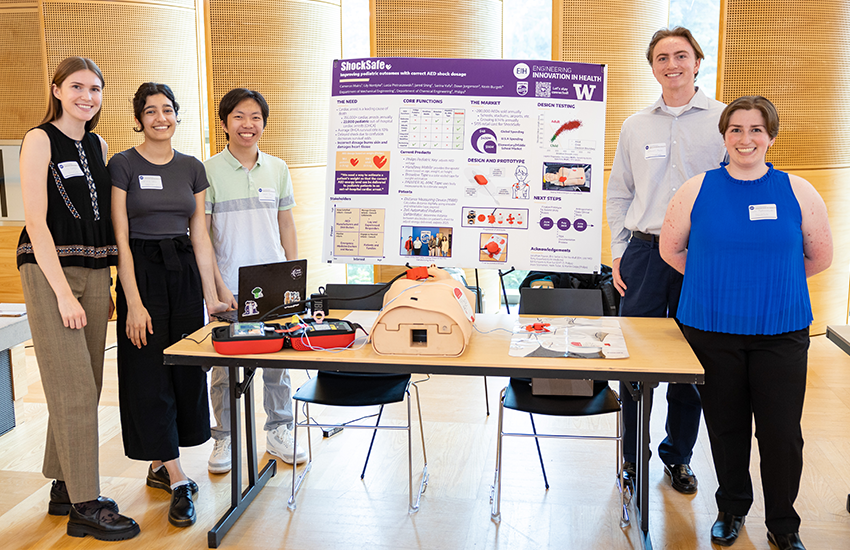By Lyra Fontaine
ShockSafe, developed by students with the help of mentors from Philips and Engineering Innovation in Health (EIH), can distinguish between children and adults during cardiac arrest emergencies.

ShockSafe team members at the 2024 EIH Spring Symposium. Photo by Matt Hagen.
During a cardiac arrest, which is a leading cause of death in the U.S., an automated external defibrillator (AED) can be life-saving. The device can analyze the heart’s rhythm and, if needed, provide an electrical shock to help the heart re-establish its normal rhythm. But knowing whether to use the AED’s pediatric or adult mode is important. Delaying shock or under-shocking an adult because of confusion makes it less likely for the person to survive, and over-shocking a child can burn skin and damage heart tissue.
Currently, assessing which mode to use is based on estimating the age and weight of the person. To more accurately distinguish pediatric and adult patients during cardiac arrest emergencies, a 2023-24 EIH capstone team with ME and UW chemical engineering students has developed an AED weight-detection accessory: ShockSafe. The project was sponsored by Philips and students were mentored by Jonathan Posner, Richard and Victoria Harrington Professor in Engineering Innovation in Health, and engineers at Philips.
“Our device helps responders make a decision about whether to use an AED’s pediatric or adult mode based on the weight of the patient,” says team member Lily Nordyke (BSME ’24). “We are making the decision making process more quantitative.”
The team learned about the history of the Philips’ AEDs and interviewed first responders, as well as people who work in emergency medicine and pediatrics. They defined ShockSafe’s target audience as lay responders who may not frequently work with AEDs.
“We practiced how to ask the right questions and understand people’s experiences with the product,” says team member Sarina Vafa (B.S. ChemE, ’24).
While conducting research, the students started looking at developmental differences between adults and children. Based on the time constraints of a cardiac arrest, they decided that using anthropometric data of body measurements and proportions was the best approach. The students input this data into a machine learning regression model they developed to determine the cutoff line that determines whether an individual is a child or an adult.
After multiple iterations, the students came up with a final prototype of ShockSafe, a detachable accessory to the AED with four tabs containing small sensing devices called motor encoders. The students took inspiration from digital measuring tape when designing the tabs, which pull out to measure certain lengths across the patient’s body. The measurement is then sent to the attached computer device, which lets the responder know via voice prompting whether to provide a pediatric or adult shock dosage.
The students’ work was recognized at the UW’s 2024 Hollomon Health Innovation Challenge, where they received the Best Idea for Patient Safety prize. At the 2024 EIH Spring Symposium, the team — which includes Nordyke, Vafa, Cameron Mains (BSME ’24), ME master’s student Jared Shing and Lucia Piotraszewski (BSME ’24) — showcased their project. Their next steps are to finalize the prototype and apply for a patent.
Nordyke was drawn to the project because of her interests in pediatric medical devices and working with industry. “It was a huge benefit to work with Philips and have access to their resources, such as their connection to paramedics,” she says.
“It was my first time going through the whole design process from the idea generation to having a final prototype,” says Piotraszewski, who is interested in working in prosthetics. “I got to do something completely different that rounds out my skills as an engineer, and see what it’s like to work with medical devices and with a large company.”
Originally published August 19, 2024